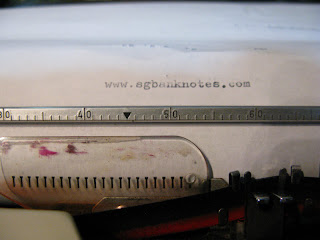The Beginning
Olympia’s story begins in Berlin on August 15, 1903. Here, under the direction of European General Electric (AEG), Dr. Friedrich von Hefner-Alteneck sought to develop a German machine to capitalize on the rising popularity and demand for typewriters. The result was the Mignon, a roller-type typewriter that didn’t fare well, as it was too expensive for many potential customers.
AEG continued to hammer away at the problems, however, finally starting full-scale production of the new, improved Mignon “AA” line in 1912. The first commercially successful Olympia, the Model 3, rolled into the marketplace just under nine years later, and two years after that, in 1923, the company set up shop in Erfurt, Germany.
By 1930, the Olympia brand name had been secured, in honor of the very last Mignon model produced, the Olympia Plurotyp of 1933. The Model 7 and Model 8 machines produced at this time, however, were sold under both the AEG and Olympia names. Later prototypes of the 1930s, including the 8a and 8b models, were simpler and cheaper, and gained popularity in the market--although a few lines, like the Filia and Super, did not last long before being pulled.
Necessary Moves
By 1943, Olympia typewriters were selling quite well, and the company had even created a one-handed version of the Model 8, for disabled users. But all was not well. As World War II raged over the European skies, the Erfurt plant suffered damage. Already reduced to just eleven employees by April of 1945, the factory survived the bombing and capture of the city by Allied forces. However, it was greatly tested by the Soviet takeover later that summer, as the East German government took control of Erfurt and everything in it--including Olympia--renaming the company “Optima”.
Several former employees fled to West Germany, though, and set up shop in 1948 in Wilhelmshaven, where Olympia typewriters continued to be made until production stopped in 1992.
Postwar Heyday
From the late nineteen forties onward, Olympia enjoyed increasing success. First, in 1949, the International Court of Justice at The Hague settled the dispute between East and West Germany over rights to the Olympia brand name. The Wilhelmshaven owners won, and officially changed the name of the company to Olympia Werke.
By 1961, about half of the typewriters in use in Germany were Olympia portables. From the popular Progress, Simplex, and Elite models to the SM2, SM3, and SF Portable--all of which maintained continuous production for sixteen years or more, from the 1950s through the 1970s--Olympia portable typewriters were known for craftsmanship, eye-catching design, and continuous innovation. Although some models never took off as planned (for example, the Orbis, which only lasted one year before being discontinued), features such as individually-spring-loaded keys provided extra comfort and cushioning, bringing in customers despite the high price point of Olympias. (In 1964, an Olympia SM7 cost $142.50--quite a hefty price tag, as this amounts to over $1,000 in today’s currency!) Even as close competitors Remington and Underwood were bought out by other companies, Olympia continued to thrive, opening new manufacturing facilities in Canada, Ireland, Mexico, and Chile, just to name a few countries.
It was during this time that Olympia produced some of its most popular models, including the SM5, which came in mod colors like caramel, mint aquamarine, and pink, and offered a script-typing option. Olympia typewriters even began to turn up in Hollywood, as Alfred Hitchcock’s 1964 thriller Marnie features Tippi Hedren as a crazed secretary, typing away and having neurotic episodes behind an Olympia SG3!
Changing Times
By the 1970s, Olympia--like most other business machine suppliers--was well aware of the threat computers presented to typewriters. Eventually, the company would branch out into calculators and computers, but before doing so, it tried many different innovations and improvements to the existing product. In 1970, Olympia introduced the SGE 50M Excellence, an electric typewriter that used proportional spacing, much like the computers of today. The firm also experimented with Dvorak keyboards, which placed the most commonly-used letters in the English alphabet more conveniently and comfortably than the standard QWERTY format. And, in 1984, even as computers took over the business world, the company kept pushing the envelope; it debuted its Olympia 1011, an important improvement over the traditional Chinese-language typewriter. Instead of the individual keys for over 2,500 characters conventionally used, the 1011 featured electrically-controlled inkjets that specially formed each character without time-consuming adjustments.
However, none of these models lasted long. The SGE 50M was only in production for three years, from 1970 until 1972, and the Dvorak machines were too expensive, costing over $300 more than a regular QWERTY typewriter.
Modern-Day Olympians
In the end, Olympia folded. Production ended in 1992, after every attempt to save the company. But Olympia typewriters are still around, often in great condition and highly prized by their owners.
Today, Olympias are especially cherished by professional wordsmiths, including Paul Auster, author of The Invention of Solitude and Man in the Dark: A Novel, among other books. His 2002 art book--The Story of My Typewriter, with painter Sam Messer--is a tribute to his SM9 manual Olympia.
Read the full article
here.


























